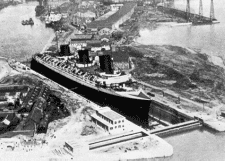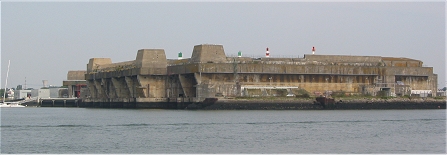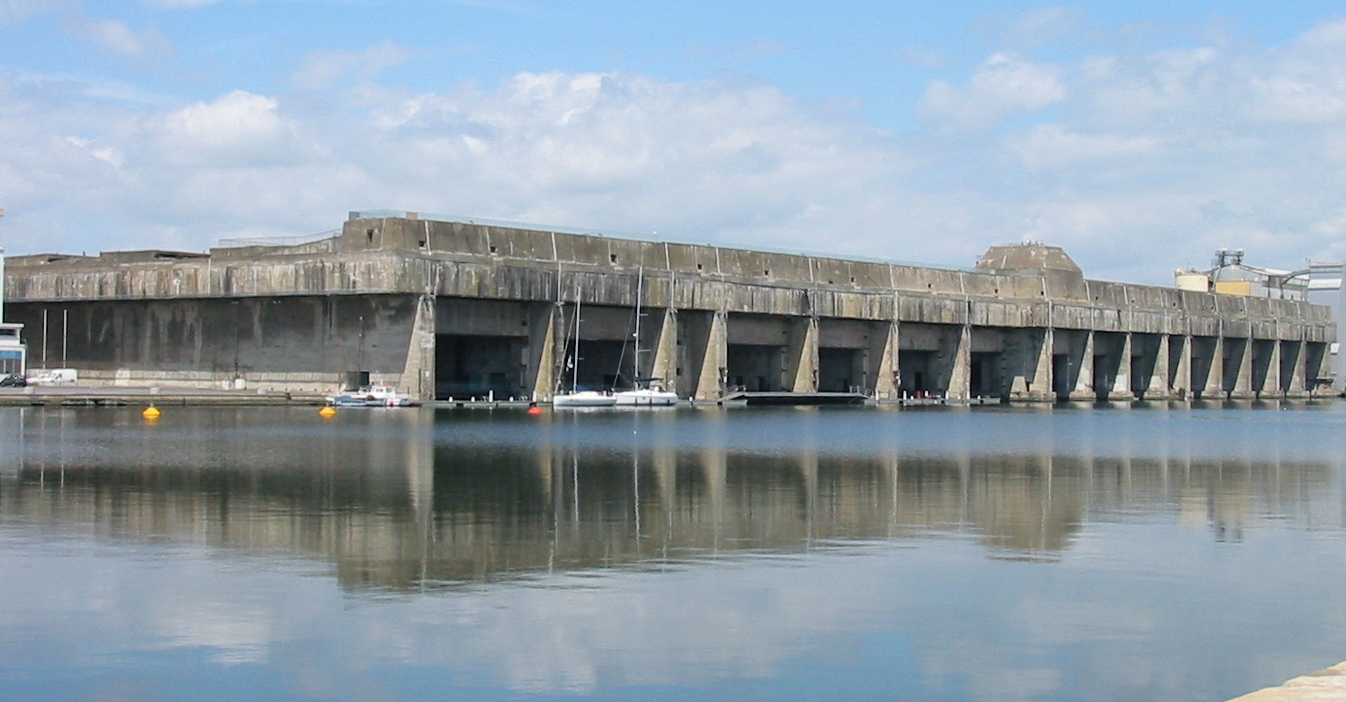|
Saint-Nazaire Submarine Base
The submarine base of Saint-Nazaire is one of five large fortified U-boat pens built by Germany during the Second World War in occupied Saint-Nazaire, France. Construction Before the Second World War, Saint-Nazaire was one of the largest harbours of the Atlantic coast of France. During the Battle of France, the German Army arrived in Saint-Nazaire, in June 1940. The harbour was immediately used for submarine operations, with the arriving as soon as 29 September 1940. In December, a mission of the Organisation Todt (Oberbauleitung Süd) inspected the harbour to study the possibilities to build a submarine pen invulnerable to air bombing from England. Work soon began under the supervision of engineer Probst. The selected space was that of the docks and buildings of the Compagnie Générale Transatlantique, which were razed. Building began in February 1941, with pens 6, 7, and 8 completed in June 1941. On 30 June 1941, Vizeadmiral Karl Dönitz formally opened the U-boat p ... [...More Info...] [...Related Items...] OR: [Wikipedia] [Google] [Baidu] |
Saint-Nazaire
Saint-Nazaire (; ; Gallo: ''Saint-Nazère/Saint-Nazaer'') is a commune in the Loire-Atlantique department in western France, in traditional Brittany. The town has a major harbour on the right bank of the Loire estuary, near the Atlantic Ocean. The town is at the south of the second-largest swamp in France, called "la Brière". Given its location, Saint-Nazaire has a long tradition of fishing and shipbuilding. The Chantiers de l'Atlantique, one of the largest shipyards in the world, constructed notable ocean liners such as , , and the cruise ship , the largest passenger ship in the world until 2022. Saint-Nazaire was a small village until the Industrial Revolution but became a large town in the second half of the 19th century, thanks to the construction of railways and the growth of the seaport. Saint-Nazaire progressively replaced upstream Nantes as the main haven on the Loire estuary. As a major submarine base for the Kriegsmarine, Saint-Nazaire was subject to a succes ... [...More Info...] [...Related Items...] OR: [Wikipedia] [Google] [Baidu] |
Lock (water Transport)
A lock is a device used for raising and lowering boats, ships and other watercraft between stretches of water of different levels on river and canal waterways. The distinguishing feature of a lock is a fixed chamber in which the water level can be varied; whereas in a caisson lock, a boat lift, or on a canal inclined plane, it is the chamber itself (usually then called a caisson) that rises and falls. Locks are used to make a river more easily navigable, or to allow a canal to cross land that is not level. Later canals used more and larger locks to allow a more direct route to be taken. Pound lock A ''pound lock'' is most commonly used on canals and rivers today. A pound lock has a chamber with gates at both ends that control the level of water in the pound. In contrast, an earlier design with a single gate was known as a flash lock. Pound locks were first used in China during the Song Dynasty (960–1279 AD), having been pioneered by the Song politician and naval en ... [...More Info...] [...Related Items...] OR: [Wikipedia] [Google] [Baidu] |
St Nazaire Raid
The St Nazaire Raid or Operation Chariot was a British amphibious attack on the heavily defended Normandie dry dock at St Nazaire in German-occupied France during the Second World War. The operation was undertaken by the Royal Navy (RN) and British Commandos under the auspices of Combined Operations Headquarters on 28 March 1942. St Nazaire was targeted because the loss of its dry dock would force any large German warship in need of repairs, such as , sister ship of , to return to home waters by running the gauntlet of the Home Fleet of the Royal Navy and other British forces, via the English Channel or the North Sea. The obsolete destroyer , accompanied by 18 smaller craft, crossed the English Channel to the Atlantic coast of France and was rammed into the Normandie dry dock south gate. The ship had been packed with delayed-action explosives, well hidden within a steel and concrete case, that detonated later that day, putting the dock out of service until 1948. A force o ... [...More Info...] [...Related Items...] OR: [Wikipedia] [Google] [Baidu] |
Lorient Submarine Base
Lorient Submarine Base was a submarine naval base located in Lorient, France. It was built in 1941 by the German Kriegsmarine, and was continued to be enlarged until 1943. After the German defeat it was used by the French Navy. It was decommissioned in 1995 and converted to civilian use. Lorient U-boat base After the fall of France in June 1940 the head of Germany’s U-boat Arm, ''Konteradmiral'' Karl Dönitz, was keen to use the French Atlantic ports as forward bases for his U-boat force then engaged in a commerce war against the United Kingdom. Prior to this U-boats had to travel from ports in Germany to their patrol areas, losing valuable time in the long transits necessary. From the coast of France these distances were substantially reduced, with a corresponding increase in the active range and endurance of the U-boat force. Dönitz lost no time in sending teams of engineers and base personnel to the ports, beginning with Lorient. Already a French naval base, Lorient had t ... [...More Info...] [...Related Items...] OR: [Wikipedia] [Google] [Baidu] |
French Submarine Espadon (S637)
''Espadon'' was a ''Narval''-class submarine of the French Navy. Along with sister boat ''Marsouin'', the boat was the first French submarine to steam under sea ice. The boat is currently a museum ship. Career ''Espadon'' was commissioned in 1960. In 1961, as she served as a target for mock torpedo exercises, ''Espadon'' was hit by two inert torpedoes, damaging her propeller. She nevertheless managed to surface, but had to be towed to Toulon. In September of the same year, while cruising underwater, ''Espadon'' collided with the submarine '' Laubie'', sustaining extensive damage to her bow and to the front of her sail. On 13 August 1963 a fire in the torpedo room wounded and intoxicated four sailors, one of whom later died of his wounds. In May 1964, ''Espadon'' and ''Marsouin'' steamed under sea ice in the Norwegian Sea as far as 70° north. ''Espadon'' undertook significant modifications from 1966 to 1968, notably upgrading the boat's sonar, sail and rudders. ''Esp ... [...More Info...] [...Related Items...] OR: [Wikipedia] [Google] [Baidu] |
Escal'Atlantic
Escal'Atlantic, is a museum that explores the historic ocean liner experience in Saint-Nazaire, France. The museum is found inside the former German World War II submarine pen in the harbour of the city port. It tells the history of the ocean liner, allowing the visitor to wander the insides of an "ocean liner" from the past by visiting areas of a vessel and by means of artefacts. History Prior to the Second World War, Saint-Nazaire was the transatlantic harbour for passenger liners travelling to Cuba, Mexico and Panama. After the fall of France in 1940, the Germans built a huge concrete submarine pen on the site of the old docks and buildings in 1941, allowing the U-boats easier access to the Battle of the Atlantic The Battle of the Atlantic, the longest continuous military campaign in World War II, ran from 1939 to the defeat of Nazi Germany in 1945, covering a major part of the naval history of World War II. At its core was the Allied naval blockade .... Museum ... [...More Info...] [...Related Items...] OR: [Wikipedia] [Google] [Baidu] |
M19 Maschinengranatwerfer
The M-19 Maschinengranatwerfer is a German 50 mm mortar which was used during World War II. The mortar was developed in 1934 for the purpose of defending permanent military bases. It had a maximum rate of fire of 120 rounds per minute and a range of 750 metres. Design Created by Rheinmetall-Borsig, it is a very heavy and complicated weapon system, with its barrel and base alone weighing 220 kg. This automatic 5 cm mortar could fire a maximum of 120 bombs a minute, and was electrically operated with manual backup. The firing rate of 120 bombs/minute was seldom used as it caused much stress and wear on the construction. It was loaded with clips of 6 bombs by two crew members. The clips were prepared by several other crew members. One gunner aimed and fired the weapon. It is unknown how many units were built, but it is estimated that the number could hardly have been much more than 150. Some mounted in the West Wall (Westwall) in Germany were removed and positioned ... [...More Info...] [...Related Items...] OR: [Wikipedia] [Google] [Baidu] |
Concrete
Concrete is a composite material composed of fine and coarse aggregate bonded together with a fluid cement (cement paste) that hardens (cures) over time. Concrete is the second-most-used substance in the world after water, and is the most widely used building material. Its usage worldwide, ton for ton, is twice that of steel, wood, plastics, and aluminum combined. Globally, the ready-mix concrete industry, the largest segment of the concrete market, is projected to exceed $600 billion in revenue by 2025. This widespread use results in a number of environmental impacts. Most notably, the production process for cement produces large volumes of greenhouse gas emissions, leading to net 8% of global emissions. Other environmental concerns include widespread illegal sand mining, impacts on the surrounding environment such as increased surface runoff or urban heat island effect, and potential public health implications from toxic ingredients. Significant research and development is ... [...More Info...] [...Related Items...] OR: [Wikipedia] [Google] [Baidu] |
Granite
Granite () is a coarse-grained (phaneritic) intrusive igneous rock composed mostly of quartz, alkali feldspar, and plagioclase. It forms from magma with a high content of silica and alkali metal oxides that slowly cools and solidifies underground. It is common in the continental crust of Earth, where it is found in igneous intrusions. These range in size from dikes only a few centimeters across to batholiths exposed over hundreds of square kilometers. Granite is typical of a larger family of ''granitic rocks'', or ''granitoids'', that are composed mostly of coarse-grained quartz and feldspars in varying proportions. These rocks are classified by the relative percentages of quartz, alkali feldspar, and plagioclase (the QAPF classification), with true granite representing granitic rocks rich in quartz and alkali feldspar. Most granitic rocks also contain mica or amphibole minerals, though a few (known as leucogranites) contain almost no dark minerals. Granite is nearly alway ... [...More Info...] [...Related Items...] OR: [Wikipedia] [Google] [Baidu] |
Reinforced Concrete
Reinforced concrete (RC), also called reinforced cement concrete (RCC) and ferroconcrete, is a composite material in which concrete's relatively low tensile strength and ductility are compensated for by the inclusion of reinforcement having higher tensile strength or ductility. The reinforcement is usually, though not necessarily, steel bars ( rebar) and is usually embedded passively in the concrete before the concrete sets. However, post-tensioning is also employed as a technique to reinforce the concrete. In terms of volume used annually, it is one of the most common engineering materials. In corrosion engineering terms, when designed correctly, the alkalinity of the concrete protects the steel rebar from corrosion. Description Reinforcing schemes are generally designed to resist tensile stresses in particular regions of the concrete that might cause unacceptable cracking and/or structural failure. Modern reinforced concrete can contain varied reinforcing materials made of ... [...More Info...] [...Related Items...] OR: [Wikipedia] [Google] [Baidu] |
Saint Nazaire Submarine Base Mg 7840
In religious belief, a saint is a person who is recognized as having an exceptional degree of holiness, likeness, or closeness to God. However, the use of the term ''saint'' depends on the context and denomination. In Catholic, Eastern Orthodox, Anglican, Oriental Orthodox, and Lutheran doctrine, all of their faithful deceased in Heaven are considered to be saints, but some are considered worthy of greater honor or emulation. Official ecclesiastical recognition, and consequently a public cult of veneration, is conferred on some denominational saints through the process of canonization in the Catholic Church or glorification in the Eastern Orthodox Church after their approval. While the English word ''saint'' originated in Christianity, historians of religion tend to use the appellation "in a more general way to refer to the state of special holiness that many religions attribute to certain people", referring to the Jewish tzadik, the Islamic walī, the Hindu rishi or Sikh gur ... [...More Info...] [...Related Items...] OR: [Wikipedia] [Google] [Baidu] |
Operation Chariot
The St Nazaire Raid or Operation Chariot was a British amphibious attack on the heavily defended Normandie dry dock at St Nazaire in German-occupied France during the Second World War. The operation was undertaken by the Royal Navy (RN) and British Commandos under the auspices of Combined Operations Headquarters on 28 March 1942. St Nazaire was targeted because the loss of its dry dock would force any large German warship in need of repairs, such as , sister ship of , to return to home waters by running the gauntlet of the Home Fleet of the Royal Navy and other British forces, via the English Channel or the North Sea. The obsolete destroyer , accompanied by 18 smaller craft, crossed the English Channel to the Atlantic coast of France and was rammed into the Normandie dry dock south gate. The ship had been packed with delayed-action explosives, well hidden within a steel and concrete case, that detonated later that day, putting the dock out of service until 1948. A force of ... [...More Info...] [...Related Items...] OR: [Wikipedia] [Google] [Baidu] |











